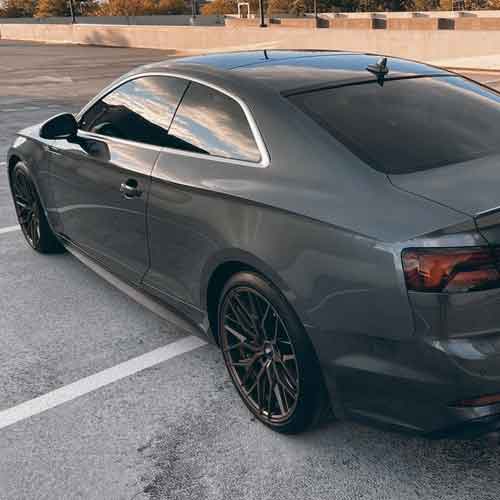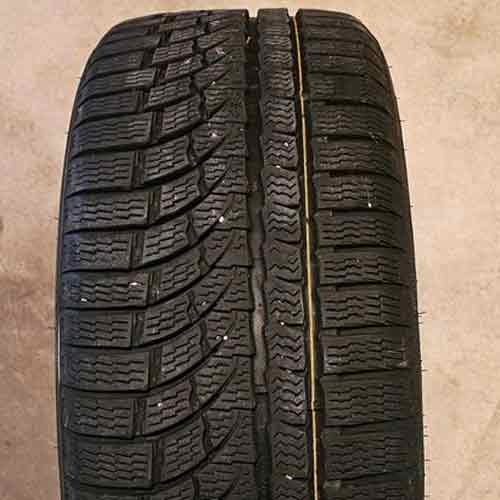The Finland-based Nokian WRG4 tire stands out in its ultra high-performance all-season category, particularly for its exceptional winter performance. But what about its performance in other critical areas? Well you’re about to find out.

Table of Contents
Key Takeaway
So the Nokian WRG4 tire excels in:
- Wet Performance: Outstanding handling and braking in wet conditions.
- Winter Traction: Superb grip on snow and ice, backed by the tri-peak rating.
- Tread Life: Durable design with a deeper tread depth, leading to a 50,000-mile warranty.
However, it needs improvements in:
- Dry Performance: Heavier construction affects braking and speed rating.
- Fuel Efficiency: Higher rolling resistance due to its design and weight.
- Handling Response: Understeer tendencies and slower handling times due to its flexible rubber compound and heavier frame.
Construction Features
The Nokian WRG4 comes with a very complicated asymmetric tread design.

As the whole tread structure is comprised of just 3 total ribs, I think it’s best if we start from the middle most one.
This rib (or block column, if you will), is narrowest of all, and is continuous-running (meaning voids don’t cut through it all the way).
And those, which almost do, act as biters, also called notches.
The shoulders, these notches face, are very laterally aligned and carry elongated wave-like siping. Moreover, they also have ridges in between, (joining up all lugs longitudinally).
On the other side, you get the widest rib of all, covering almost 60% of the tread’s real estate.
This rib although features similar siping pattern, is also characterized by curved/sharp in-groove notches, which are also interconnected to each other, by longitudinal voids.
Internally, the tire comes with a relatively heavier construction of 2 ply polyester, 2 steel belts, and 2 ply nylon (where mostly other high performance AS tires only come with a single ply polyester/nylon structures).
Compare Nokian WRG4 with others:
- Firestone WeatherGrip
- Michelin CrossClimate 2
- Bridgestone WeatherPeak
- Goodyear Assurance WeatherReady
Sizes and their Specs
Nokian WRG4 comes in 14 to 20 inches rims, having following specs.
- Speed ratings: H, V and W.
- Load ratings: XL, and SL.
- Weight range: 16 to 40 lbs.
- UTQG: 500 A A.
- Treadwear warranty: 60k miles.
- All sizes have the 3pmsf and M+S certifications.
- Tread depth: 11/32″ on all.
Winter Performance
When assessing winter tire performance, it’s crucial to recognize the unique challenges posed by different road conditions.
I mean here, while icy surfaces demand tires with numerous biting edges for grip, deep snow requires lugs/biters capable of effective scooping.
In this context, the Nokian WRG4 stands out, and it makes sense since its awarded with the three-peak mountain snowflake rating, signifying superior snow and ice performance. (This rating is rarely seen in ultra high performance AS tires).
So this is the biggest pro of this AS tire. See the list of pros and cons of all-season tires, just an FYI.
So what makes Nokian great here?
Well for one, its tread is engineered with a complex pattern of interlocking and linear sipes, oriented in various directions, and maintains flexibility even in freezing temperatures, preventing hardening.
Moreover, the tire’s design includes, slanted wave-like sipes for improved traction on ice, and in-groove notches with sharp edges for better grip in softer, snowy conditions.
Moreover, with 3PMSF rating, it makes sense why the tire gets leading scores, when it comes to snow acceleration.
This is because that’s what this rating is all about. It just gives you a rough idea, about snow acceleration. I talked about it here, in greater details.
Dry Performance
Assessing the effectiveness of a tire’s dry traction involves examining multiple aspects such as its structure, material composition, and tread pattern.
These elements are crucial in determining the tire’s adherence to the road under dry conditions. And their effectiveness is typically measured through tests that evaluate acceleration, braking, cornering abilities, and steering response.
Let’s start with the grip.
Directional Grip
Now this grip is measured by tire’s braking distance, and is largely depends on the tread’s central region. And that’s simply because this area meets the most with the road, as the tire rolls in a straight line.
In this regard, the Nokian WRG4 demonstrates impressive dry braking capabilities, stopping only a foot longer than its main competitor, the General G Max AS-05 (review), which is also a strong contender in the ultra-high performance (UHP) all-season tire category.
So the Nokian tire here comes with 3 central ribs (featuring an asymmetric design), equipped with various gripping elements, or in-groove notches (as discussed in the tire’s construction section above).
A distinctive characteristic of these biters is their varied angular orientation, providing not just consistent longitudinal grip but also multi-directional stability, which is vital for lateral traction during maneuvering.
Additionally, the tire’s continuously running central ribs, ensure constant contact between the rubber and the road, further aiding it’s overall grip.
But yes, the tire performance could be slightly improved if it were not for its heavier construction. And here the tire’s internal construction, with the combination of dual nylon and polyester plies, is the main culprit.
(I mean, in comparison, most of its competitors only come with a single ply nylon and polyester cords).
This added weight impacts the tire’s braking, as greater mass leads to increased momentum, making it more challenging to stop. This is likely why the Nokian WRG4’s speed ratings cap at W, rather than Y, which is common in high-end UHP category.
See other all-season categories here, if you’re wondering.
Overall Handling
When evaluating the overall handling of a tire, two critical factors come into play: the tire’s grip and its responsiveness to driver inputs.
Talking about lateral grip first, it depends on shoulder lugs, as they meet the most with the road, as the tire turns.
And for the Nokian WRG4, there are no complaints here. I mean the tire’s shoulders are pretty well optimized, as they come equipped with effective multi-directional biters, and provide a substantial contact patch.
This design results in lateral grip values that are comparable to some high-end tires in the market.
So then why the tire lacks in overall handling times to others? Well, this has to do with it’s slightly lacking steering response, where the tire tends to understeer, for the most part.
This happens because the tire is made with a heavier frame and a more flexible rubber compound, and both of these disrupt the overall under/over-steering balance, as they push the lugs down to bend more.
Moreover, it’s greater tread depth is also not helping here, as it further makes it’s lugs susceptible to bending.
So where the tire is leading in lateral traction, it comes out with one of the slowest handling times, ironically.
For Your Info: Among all the tires I’ve reviewed in the ultra-high-performance all-season category, the Pirelli All Season Plus stands out, offering the most superior overall dry handling.
Tread Life
The tread longevity of a tire is determined by various factors, and a “good tire” with better tread life typically combines several attributes.
A stiffer rubber composition helps resist rapid wear, while greater tread depth means it takes longer to reach the replacement level.
Similarly, lighter construction in tires reduces the weight pressure on the lugs, and a uniform tread pattern ensures even weight distribution, preventing uneven wear and various types of tread deformations.
In light of these factors, the Nokian WRG4 performs acceptably.
Although its substantial internal construction and increased lug flex result in higher rolling resistance, its well-crafted tread pattern assists in evenly distributing the weight across the tread.
Moreover, the tire’s relatively deeper tread depth also contributes to its longevity, requiring more time to wear down to the minimum legal tread depth of 2/32 inches in the USA.
And so it makes sense why the tire comes with 500 treadwear rating, and a 60k miles warranty.
P.S. You can always check the tread depth by a penny, check this: https://tiredriver.com/how-to-check-tire-tread-depth-with-penny/
Wet Performance
Achieving dependable wet traction is notably more challenging than dry grip due to the necessity of timely water evacuation.
I mean, since the water is not compressible, it has to be displaced off the tread, otherwise it would come in the way.
And here, the Nokian WRG4 demonstrates exceptional performance. The tire excels in wet handling, leading its budget category competitors.
Its wet braking performance, while not topping the charts, is appreciable, and still comes as above-average, ranking in the middle.
To put this into perspective, when compared with the high-end Michelin Pilot Sport All Season 4 (review), the WRG4 only falls short by 2.5 feet.
In terms of steering response under wet conditions, the Nokian tire is again doing great, where its sharp and precise, offering drivers confidence and control
So what makes this tire great here?
Well, the tire’s impressive wet traction can be attributed to its advanced siping structure, where it features a combination of rectilinear and interlocking biters, along with angled wave-like siping, ensuring effective water displacement.
These sipes basically push the water particles in to their slits, as they are pressured between the tire’s rubber and the road’s surface.
Moreover, with an array of curved, lateral and longitudinal grooves, the tire takes out more water from the start, leaving behind less for sipes to deal with. So you also get pretty decent resistance to hydroplaning as well here.
Fuel Economy
Fuel efficiency in tires is intricately linked to rolling resistance, and in this regard, the Nokian WRG4 doesn’t particularly excel.
Despite its tread being engineered to optimize the contact patch and evenly distribute pressure, enhancing longevity, the tire’s overall performance in fuel efficiency is not impressive.
This under-performance can be attributed to two main factors:
- The asymmetric tread design of the WRG4, coming with numerous biting edges, increases friction between the tire and the road, increasing rolling resistance.
- The tire’s weight leans towards the heavier side. And this combined with its softer tread compound, the lugs are pushed down, and forced to flex more, leading to energy loss (where it gets converted in to heat).
However, it’s important to note that the Nokian WRG4 still outperforms many other tires in its category in terms of fuel economy.
While it may not offer the same level of grip or high speed ratings (up to Y, as most other UHPAS tires do), it compensates with better fuel efficiency.
Side Note: If you want to learn more about fuel economy, I’d recommend checking out Do All-Season Tires Use More Fuel?
Summing It Up
The Nokian WRG4 comes out as a decent budget friendly pick, in its ultra high performance all season category.
On dry roads, although the tire offers great braking performance, it lacks slightly due to its sluggish steering.
Though that’s not the issue on wet, where both lateral and directional grip are doing great, along with the tire’s steering feedback.
Winter performance is its strongest of all suits, where the tire offers you with a lot of biters, and 3 peak rating.
And although the tire does not offer ample fuel economy, it does give you very long lasting tread, with a treadwear warranty of 50k miles.